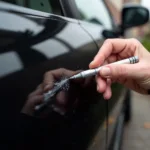Matte car paint offers a unique and stylish look that sets your vehicle apart from the crowd. Unlike traditional glossy finishes, matte paint absorbs light, creating a smooth, non-reflective surface that exudes sophistication. However, maintaining this distinctive appearance requires specialized care and attention.
While matte car paint is durable, it is more susceptible to certain types of damage like scratches, swirl marks, and water spots. Conventional car wash methods and products designed for glossy finishes can often exacerbate these issues, diminishing the matte effect. This is where understanding the nuances of matte car paint repair becomes crucial.
Understanding Matte Car Paint
Matte car paint differs from glossy paint in its composition. While glossy paints contain a clear coat layer that provides shine and protection, matte paints have a flattened clear coat or, in some cases, no clear coat at all. This unique structure contributes to the characteristic non-reflective finish but also makes it more susceptible to micro-scratches and blemishes.
Common Matte Car Paint Problems
Matte car paint, while stylish, requires meticulous care to maintain its unique appearance. Here are some common problems:
- Scratches and Swirl Marks: Matte finishes are more prone to showing light scratches and swirl marks, especially under direct sunlight. These imperfections can disrupt the uniform matte look.
- Water Spots: Due to the absence of a high-gloss clear coat, water droplets can etch into the paint, leaving behind noticeable water spots if not dried immediately.
- Bird Droppings and Contaminants: Bird droppings and environmental contaminants can quickly damage the delicate matte finish if not removed promptly and carefully.
- Improper Washing and Drying Techniques: Using harsh detergents, abrasive cloths, or automatic car washes can create swirl marks and damage the matte surface.
DIY vs. Professional Matte Car Paint Repair
Minor imperfections like light scratches or water spots might be addressable with DIY methods using specialized matte car care products. However, more significant damage like deep scratches, extensive swirl marks, or paint chips often necessitate professional intervention.
DIY Matte Car Paint Repair:
- Matte Car Wash Soap: Use pH-neutral, specifically designed matte car wash soaps that won’t strip away the delicate finish.
- Microfiber Wash Mitt: Always use a soft microfiber wash mitt to prevent scratching.
- Matte Paint Sealant: Apply a quality matte paint sealant to add a layer of protection against environmental contaminants.
Professional Matte Car Paint Repair:
Professionals possess the expertise, tools, and specialized products to restore your matte finish effectively. Here’s what to expect:
- Assessment and Diagnosis: A thorough assessment of the damage to determine the appropriate repair strategy.
- Paint Correction: Techniques like wet sanding, machine polishing, and buffing using matte-specific products to remove imperfections.
- Matte Clear Coat Application: In some cases, a new layer of matte clear coat might be necessary to achieve a uniform finish.
Tips for Maintaining Matte Car Paint
Maintaining the pristine look of your matte car paint requires a proactive approach. Here are some valuable tips:
- Regular Washing: Wash your car frequently using the proper techniques and products mentioned earlier.
- Immediate Drying: Dry the car immediately after washing to prevent water spots.
- Avoid Automatic Car Washes: The harsh brushes and strong detergents used in automatic car washes can damage matte paint.
- Prompt Contaminant Removal: Clean bird droppings, tree sap, and other contaminants as soon as possible.
- Protective Coverings: Consider using a car cover when parking outdoors for extended periods.
Choosing the Right Detailer
Selecting a reputable and experienced detailer is crucial for achieving satisfactory matte car paint repair results. Look for professionals who:
- Specialize in Matte Finishes: Ensure they have experience working with matte paint and understand its unique requirements.
- Use Quality Products: Inquire about the products they use and ensure they are specifically designed for matte finishes.
- Provide Transparent Communication: A reputable detailer will explain the repair process, provide a clear estimate, and address any concerns you might have.
Conclusion
Matte car paint repair demands specialized knowledge and techniques. While minor issues might be manageable with DIY methods, professional help is often necessary for significant damage. By understanding the nuances of matte car paint care and repair, you can keep your vehicle looking its best for years to come.
FAQs
1. Can I wax my matte car paint?
No, traditional waxes are designed for glossy finishes and can leave streaks and a shiny residue on matte paint.
2. How often should I wash my matte car?
It’s recommended to wash your matte car every one to two weeks, or more frequently if it’s exposed to harsh environmental conditions.
3. Are touch-up paints available for matte finishes?
Yes, touch-up paint pens designed for matte finishes are available. However, it’s crucial to find an exact match for your car’s paint code.
4. Is matte car paint more expensive to repair?
Matte car paint repairs can be slightly more expensive due to the specialized products and techniques involved.
5. Can I convert my glossy car paint to matte?
Yes, it’s possible to achieve a matte finish on a car with glossy paint through a process called vinyl wrapping or by applying a specialized matte clear coat.
Need Help With Your Matte Car Paint?
For expert advice and assistance with matte car paint repair, contact us via WhatsApp: +1(641)206-8880 or email: [email protected]. Our team of specialists is available 24/7 to answer your questions and provide top-notch service.


